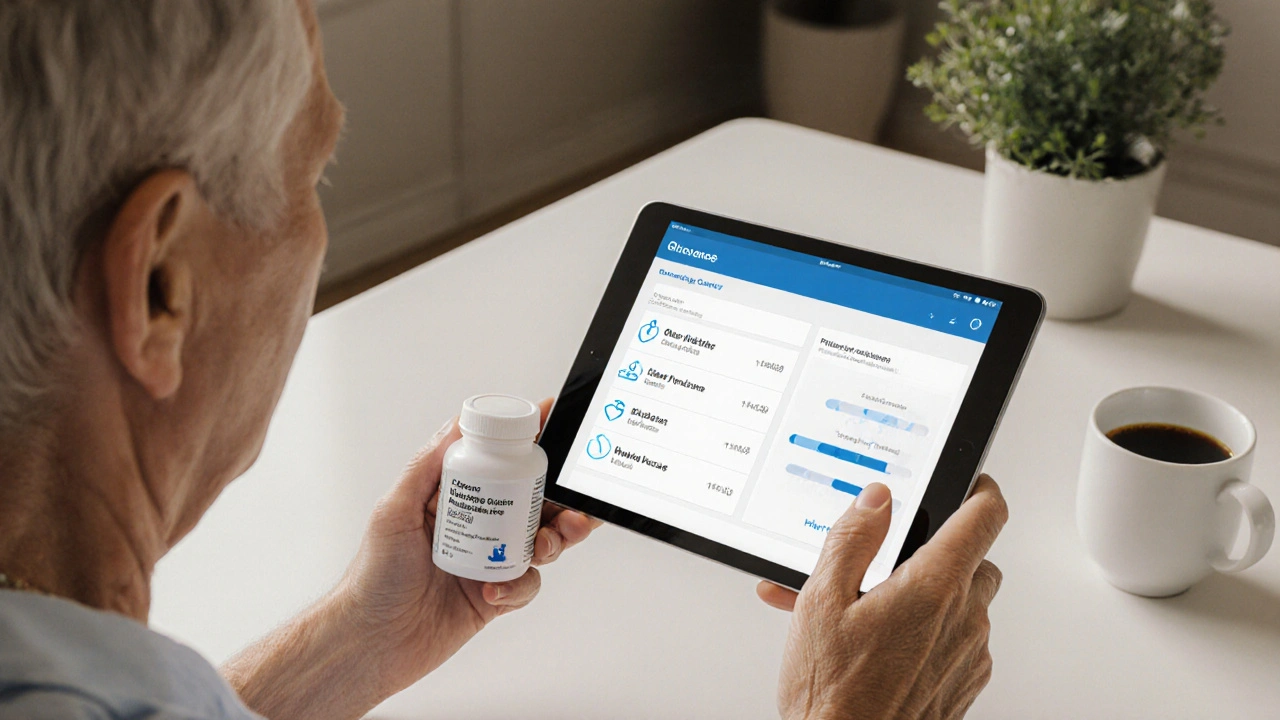Glucovance vs Alternatives: Which Diabetes Combo Works Best?
 Oct, 4 2025
Oct, 4 2025
Diabetes Combo Medication Selector
Recommended Alternative
When you or a loved one is prescribed a pill that combines two diabetes agents, the first question is usually: “Is this the best choice?” This article lines up Glucovance comparison against the most common alternatives so you can see where it shines and where it falls short.
Key Takeaways
- Glucovance blends metformin and glibenclamide, offering two mechanisms in one tablet.
- It works well for patients who need strong glucose‑lowering power but can tolerate a higher hypoglycemia risk.
- Newer combos (e.g., Janumet) add cardiovascular benefits and lower weight gain.
- Monotherapy with metformin remains the safest first‑line option for most new‑onset type2 diabetes.
- Cost, dosing convenience, and side‑effect profile are the main decision drivers.
What Is Glucovance?
Glucovance is a fixed‑dose combination of metformin - a biguanide that lowers hepatic glucose production - and glibenclamide (also known as glyburide), a sulfonylurea that stimulates insulin release from pancreatic beta cells.. It is marketed for adults with type2 diabetes who need an additional sulfonylurea on top of metformin to reach target A1C levels.
How the Two Components Work Together
Metformin targets the liver, reducing the amount of glucose it pumps into the bloodstream. Glibenclamide, on the other hand, tells the pancreas to pump more insulin. By hitting both ends - production and utilization - Glucovance can drop A1C by 1.5-2.0% in many patients.
Pros and Cons of Glucovance
- Pros
- Two drugs in one pill - less pill burden.
- Proven efficacy: large trials show consistent A1C reductions.
- Metformin’s weight‑neutral or modest weight‑loss effect can offset the weight gain often seen with sulfonylureas.
- Cons
- Higher risk of hypoglycemia, especially in elderly or those with renal impairment.
- Glibenclamide can cause prolonged low blood sugar because of its long half‑life.
- Limited cardiovascular benefit compared with newer drug classes.
Popular Alternatives to Glucovance
Below are the most frequently considered options when a clinician thinks Glucovance might not be the perfect fit.
- Janumet - a fixed‑dose combo of metformin and the DPP‑4 inhibitor sitagliptin. Offers lower hypoglycemia risk and modest weight loss.
- Metformin monotherapy (often the first step before any sulfonylurea).
- Glibenclamide alone - useful when a patient cannot tolerate metformin.
- Empagliflozin - an SGLT2 inhibitor that improves glucose control, reduces blood pressure, and cuts heart‑failure risk.
- Liraglutide - a GLP‑1 receptor agonist that promotes weight loss and offers strong cardiovascular protection.

Side‑Effect Profiles at a Glance
| Medication | Mechanism | Typical Dose Frequency | Cost (USD/month) | Weight Impact | Hypoglycemia Risk | Cardiovascular Benefit |
|---|---|---|---|---|---|---|
| Glucovance | Metformin + Glibenclamide | Twice daily | ≈ $30 | Neutral‑to‑slight gain | High | None proven |
| Janumet | Metformin + Sitagliptin (DPP‑4) | Twice daily | ≈ $70 | Neutral | Low | Modest |
| Metformin alone | Biguanide | Once or twice daily | ≈ $4 | Weight loss | Very low | Neutral |
| Empagliflozin | SGLT2 inhibitor | Once daily | ≈ $60 | Weight loss | Low | Strong (HF, CV death) |
| Liraglutide | GLP‑1 receptor agonist | Daily injection | ≈ $120 | Weight loss | Low | Strong (MACE reduction) |
When Glucovance Is the Right Choice
If you already take metformin and need a stronger push, Glucovance offers a quick A1C dip without adding another pill. It works best for:
- Patients with stable kidney function (eGFR ≥ 60mL/min/1.73m²).
- Those without a history of severe hypoglycemia.
- People who prioritize cost; generic Glucovance is cheaper than most newer combos.
When to Look Elsewhere
Switching away from Glucovance makes sense if any of the following apply:
- Frequent low blood sugars or episodes of nocturnal hypoglycemia.
- Weight gain is a concern; SGLT2 inhibitors or GLP‑1 agonists can help shed pounds.
- Established cardiovascular disease - evidence now favors SGLT2 inhibitors and GLP‑1 agonists.
- Renal impairment that makes sulfonylureas risky.
How to Switch Safely
- Talk to your prescriber about a taper plan - abrupt stops can cause rebound hyperglycemia.
- If moving to a DPP‑4 inhibitor combo, keep metformin at the same dose and add sitagliptin gradually.
- For SGLT2 inhibitors, ensure eGFR is adequate and monitor for urinary tract infections.
- When starting GLP‑1 agonists, begin with a low‑dose titration to minimize nausea.
- Schedule a follow‑up A1C test in 3 months to gauge effectiveness.
Cost Considerations in 2025
Insurance formularies vary, but in most Pacific‑North‑American plans, the generic version of Glucovance sits under the $30/month tier, while Janumet and newer agents sit in higher co‑pay brackets. Some health services now provide discounts for SGLT2 inhibitors if the patient meets cardiovascular criteria, which can bring empagliflozin closer to Glucovance’s price point.
Bottom Line Decision Tree
- Start with metformin alone → If A1C still >7.5%, consider adding a second agent.
- Is cost the primary driver?
Yes → Glucovance (if hypoglycemia risk acceptable). - Is there established heart disease or high CV risk?
Yes → Empagliflozin or Liraglutide (better outcomes). - Concern about weight gain?
Yes → Janumet, Empagliflozin, or Liraglutide (all weight neutral or loss). - Prior episodes of low blood sugar?
Yes → Avoid sulfonylureas; favor DPP‑4 or SGLT2 inhibitors.

Frequently Asked Questions
Can I take Glucovance if I have kidney problems?
Glucovance contains metformin, which is cleared by the kidneys. If your eGFR drops below 60mL/min/1.73m², doctors usually lower the metformin dose or switch to another regimen. The sulfonylurea part also accumulates in renal dysfunction, raising hypoglycemia risk. Talk to your clinician before continuing.
How does the hypoglycemia risk of Glucovance compare to Janumet?
Glibenclamide in Glucovance has a long half‑life and can cause low blood sugar even hours after a missed meal. Janumet’s sitagliptin component works by enhancing glucose‑dependent insulin secretion, which means it rarely causes hypoglycemia unless combined with another insulin‑secretagogue. Overall, Janumet’s risk is markedly lower.
Does Glucovance help with weight loss?
Metformin often leads to modest weight loss, while glibenclamide can cause slight weight gain. The net effect of Glucovance is usually weight‑neutral, but if you’re aiming to shed pounds, an SGLT2 inhibitor or GLP‑1 agonist may be a better fit.
Is there a generic version of Glucovance?
Yes, several manufacturers sell the metformin‑glibenclamide combo as a generic. Prices typically range from $25 to $35 per month, making it one of the most affordable dual‑therapy options on the market.
Can I switch from Glucovance to a single‑pill combo like Janumet without stopping metformin?
Yes. Since both combos contain metformin, you can simply replace Glucovance with Janumet, adjusting the dose of the second component as your doctor advises. A short overlap may be needed to avoid a gap in sulfonylurea coverage, but most clinicians taper the glibenclamide portion over a few days.

Fatima Sami
October 4, 2025 AT 14:43While the article is thorough, I couldn't help noticing the inconsistent spelling of “hypoglycemia” – it should be without the extra “a”. Other than that, the breakdown of cost versus benefit is well‑structured.
Arjun Santhosh
October 5, 2025 AT 13:58Thanks for the info! i think its super helpful for people who are trying to decide. The table made it easy to see which med is cheaper and which one has less weight gain.
Stephanie Jones
October 6, 2025 AT 13:13The choice of a medication feels like a metaphor for life's trade‑offs: we balance the sweet promise of lower A1C against the bitter risk of hypoglycemia. In the end, every pill is a tiny pact with our own mortality.
Nathan Hamer
October 7, 2025 AT 12:28Wow!!! This guide is like a beacon in the fog of diabetes management 🌟💊! The way you laid out the cardiovascular benefits really shines, and the emojis totally capture the excitement!!!
Tom Smith
October 8, 2025 AT 13:01Oh, absolutely-because when I think “cost‑effective,” I instantly think “glibenclamide cocktail.” Nothing says ‘smart choice’ like a sulfonylurea that can drop you into a hypoglycemic deep‑sea dive.
Kyah Chan
October 9, 2025 AT 10:58It is with the utmost dismay that I observe the article's failure to address the pharmacokinetic intricacies of glibenclamide’s prolonged half‑life. Such oversight is unbecoming of a purportedly scholarly exposition.
Ira Andani Agustianingrum
October 10, 2025 AT 11:15Great job on the comparison! If you’re on Glucovance and worried about weight, consider pairing it with a low‑calorie diet and regular walks. Small lifestyle tweaks can offset the minor weight gain from the sulfonylurea.
James Higdon
October 11, 2025 AT 11:31From an ethical standpoint, prescribing a drug with known high hypoglycemia risk to vulnerable populations is questionable. We must prioritize patient safety over mere cost savings.
Wanda Smith
October 12, 2025 AT 11:48One must wonder why the pharma giants aren't shouting louder about the hidden agenda behind promoting sulfonylureas. The data is there, but the narrative is conveniently muted.
Bridget Jonesberg
October 13, 2025 AT 12:05In the grand tapestry of therapeutic decision‑making, one cannot simply enumerate cost, weight, and cardiovascular outcomes without invoking the profound philosophical undercurrents that dictate our very perception of health. The very act of selecting a pharmacologic regimen is an exercise in existential deliberation, wherein the patient assumes the role of both author and protagonist, navigating the labyrinthine corridors of biomedical literature and personal experience. Moreover, the juxtaposition of Glucovance against its contemporaries serves as a microcosm of the broader dialectic between tradition and innovation; the former, embodied by the venerable sulfonylurea, exudes a weathered reliability, while the latter, exemplified by SGLT2 inhibitors and GLP‑1 agonists, heralds a future replete with cardioprotective promise. The nuanced interplay of these forces compels the clinician to weigh not merely the quantitative metrics of A1C reduction, but also the qualitative dimensions of patient autonomy, quality of life, and the ever‑looming specter of adverse events. Ultimately, the decision matrix presented in the article is not a static tableau but a dynamic, living document, reflecting the mutable nature of medical knowledge and the inexorable march of scientific progress.
Marvin Powers
October 14, 2025 AT 12:21Oh, look at this-another brilliant checklist that pretends to solve the complex puzzle of diabetes care. As if the patient can just read a table and instantly become a master of metabolic regulation. Spoiler: they still need a doctor, a diet, and a whole lot of patience.
Jaime Torres
October 15, 2025 AT 12:38Nice summary.
Wayne Adler
October 16, 2025 AT 12:55I totally get why hypoglycemia scares you-it's a real threat. If you switch, do it slow and monitor your sugar levels at least twice a day, ok? Don't ignore the signs, it's not worth the risk.
Shane Hall
October 17, 2025 AT 13:11Here’s a step‑by‑step guide for anyone thinking about moving off Glucovance: first, check your eGFR; second, taper the glibenclamide over a week while keeping metformin steady; third, introduce the new agent (e.g., empagliflozin) at a low dose and titrate up; fourth, schedule A1C testing in three months. Following this protocol can smooth the transition and minimize rebound hyperglycemia.
Christopher Montenegro
October 18, 2025 AT 13:28From a pharmacoeconomic perspective, the incremental cost‑effectiveness ratio (ICER) of Glucovance versus empagliflozin fails to meet the willingness‑to‑pay threshold in high‑income markets, particularly when accounting for downstream cardiovascular events and hospitalization costs associated with hypoglycemia.
Kyle Olsen
October 19, 2025 AT 13:45One must acknowledge that the presented data, while comprehensive, neglects the pivotal role of patient‑centered outcomes in therapeutic selection.
Sarah Kherbouche
October 20, 2025 AT 14:01Honestly, it's crazy how some folks still push Glucovance when we have American‑made options that are better for our health. We shouldn't settle for cheap foreign meds when we have the best.